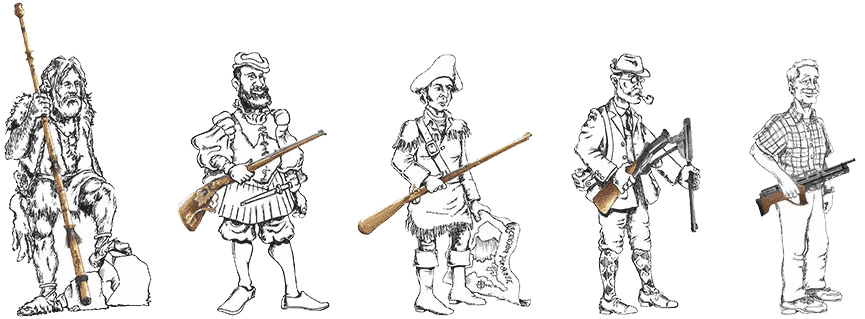The world of airguns represents a fascinating intersection of history, engineering precision, and sporting craftsmanship. For collectors and enthusiasts alike, these compressed-air wonders offer a unique glimpse into the evolution of shooting technology that spans centuries. The airgun’s journey from primitive bellows-powered mechanisms to today’s high-tech precision instruments tells a compelling story of innovation and adaptation that continues to evolve with each passing year.
The origins of the airgun can be traced back to the 15th century, where early bellows guns represented the first attempts to harness compressed air for propulsion. These primitive devices, though rudimentary by today’s standards, laid the groundwork for centuries of development. The transition from fragile leather bellows to sturdier metal reservoirs in the 17th century marked a significant turning point, enabling more powerful airguns capable of taking down larger game and eventually finding their way into military applications.
Perhaps no collection better showcases the breadth and depth of airgun history than the carefully curated displays featured on MKGuns.co.uk. From vintage Webley pistols to rare collectibles, these pieces represent not just functional shooting implements but cultural artifacts that tell the story of their era. The craftsmanship evident in these historical pieces demonstrates an attention to detail and engineering prowess that many modern manufacturers still strive to match.
The 18th and 19th centuries saw tremendous innovation in airgun technology, with the Girandoni air rifle representing perhaps the most significant advancement of the period. This remarkable weapon, with its 20-round magazine capacity and considerable power, even accompanied Lewis and Clark on their famous expedition. The fact that a compressed-air weapon was chosen for such a crucial journey speaks volumes about the reliability and effectiveness of well-crafted airguns, even in that early period of development.
As we moved into the 20th century, companies like Webley & Scott established themselves as premier manufacturers, setting benchmarks for quality and performance that would influence generations of airgun designs. Their innovations in spring-piston technology and later pre-charged pneumatic systems helped shape the modern airgun landscape we know today. The legacy of these pioneering companies continues to influence contemporary designs, with many collectors specifically seeking out vintage models for their historical significance and exceptional build quality.
The Rise of Modern Airgun Technology
Today’s airgun market presents an astonishing array of technologies that would seem like science fiction to early airgun craftsmen. Pre-charged pneumatic (PCP) systems have revolutionised the industry, offering unparalleled power, accuracy, and consistency. These sophisticated airguns utilise high-pressure air reservoirs capable of delivering multiple shots with remarkable precision, making them ideal for competitive target shooting and ethical hunting.
Electronic advancements have further transformed the airgun landscape. Digital pressure gauges, electronic triggers with adjustable pull weights, and programmable firing cycles allow shooters to customise their experience with unprecedented precision. Some high-end models even feature integrated ballistic computers that account for environmental factors like temperature, humidity, and altitude to maximise accuracy at extended ranges.
Materials science has similarly advanced the field, with aircraft-grade aluminium, carbon fibre, and advanced polymers replacing traditional wood and steel in many models. These modern materials offer superior strength-to-weight ratios, improved durability in adverse conditions, and resistance to warping or expansion with humidity changes—all critical factors for maintaining consistent accuracy.
The diversity of airgun types available today reflects their versatility and growing popularity. Break-barrel spring pistons remain popular for their self-contained simplicity, while CO2-powered models offer convenience for recreational shooting. Meanwhile, sophisticated bullpup designs prioritise compact handling without sacrificing power or accuracy, demonstrating how airgun technology continues to evolve to meet specific shooting needs.
https://www.youtube.com/watch?v=9mM3cwyYCeY
The Collector’s Perspective
For collectors, airguns represent a uniquely accessible entry point into historical firearms. Unlike many traditional firearms, vintage airguns often remain fully functional despite their age, allowing enthusiasts to not only display these pieces but also experience them as their original owners would have. This hands-on connection to history provides a tangible link to the past that few other collectibles can match.
The value of vintage airguns has seen substantial appreciation in recent years, with rare models commanding impressive prices at specialist auctions. Factors such as condition, originality, historical significance, and provenance all play crucial roles in determining a piece’s value. For serious collectors, documentation of an airgun’s history—including original manuals, purchase receipts, or competition records—can substantially enhance both its historical significance and monetary worth.
Some of the most sought-after pieces include pre-war Webley pistols, early Diana models, and limited production runs from manufacturers like BSA and Feinwerkbau. The craftsmanship evident in these vintage pieces often surpasses that of their modern counterparts, with hand-fitted parts and meticulous attention to detail that reflects an era when mass production had not yet fully supplanted artisanal manufacturing methods.
Iconic Models That Shaped the Industry
The Diana Model 6
Among the pantheon of classic airguns, the Diana Model 6 stands as an exemplar of mid-20th century design excellence. This spring-piston pistol combined remarkable accuracy with reliability that has allowed many examples to remain in shooting condition decades after manufacture. Its distinctive profile and comfortable grip made it a favourite among target shooters and casual plinkers alike, while its robust construction ensured these pistols would be passed down through generations.
The Webley Senior
The Webley Senior represents another milestone in airgun evolution. This break-barrel pistol’s innovative design set new standards for power and accuracy in its day, while its distinctive over-lever cocking mechanism became instantly recognisable to enthusiasts worldwide. The Senior’s enduring popularity speaks to both its functional excellence and the emotional connection many shooters form with these characterful pieces.
The Modern FX Impact
In the contemporary sphere, few models have made as significant an impact as the aptly named FX Impact. This modular, highly customisable PCP rifle revolutionised the market with its adaptability to different calibres, barrel lengths, and power configurations. The Impact demonstrates how modern manufacturing techniques and materials can be combined to create a platform that evolves with the shooter’s needs and preferences.
The Modern Airgun Community
The contemporary airgun community represents a diverse and growing segment of the shooting sports world. Online forums, speciality publications, and dedicated YouTube channels have created a vibrant ecosystem where enthusiasts can share knowledge, techniques, and experiences. This interconnectedness has accelerated the spread of information and innovations, fuelling further growth in the hobby.
Competitive airgun shooting has also seen remarkable growth, with disciplines ranging from formal 10-meter Olympic events to field target competitions that test shooters’ abilities in variable outdoor conditions. These competitions have driven technological advancements as manufacturers strive to provide competitors with every possible advantage, resulting in trickle-down improvements that benefit casual shooters as well.
The environmental and practical advantages of airguns have further contributed to their popularity. Their relatively quiet operation makes them suitable for use in areas where noise restrictions might prohibit traditional firearms. The lower cost of ammunition, absence of powder residue, and ability to safely practice in more confined spaces also make airguns an attractive option for regular practice and skills development.
Conservation and Ethical Considerations
The modern airgun community places significant emphasis on ethical shooting practices and conservation efforts. Whether for pest control or hunting, today’s airgun enthusiasts understand the importance of clean, humane kills and responsible wildlife management. Advanced optics and increasingly accurate airgun systems have made this ethical approach more achievable than ever before.
Many shooters also participate in conservation initiatives, recognising that responsible land management and habitat preservation are essential for the future of their sport. This environmental consciousness represents an important evolution in the shooting community’s ethos, reflecting broader societal shifts toward sustainability and ecological awareness.
Looking to the Future
As we look toward the horizon of airgun development, several trends appear poised to shape the next generation of these fascinating tools. Continued refinement of PCP technology, including more efficient valving systems and improved air management, promises to deliver even greater consistency and shot counts from compact reservoirs.
Integration of electronic components seems likely to accelerate, with smart technology potentially offering features like shot counters, pressure monitoring systems, and even ballistic calculations integrated directly into the sighting systems. For competition shooters, these advancements could provide valuable data to refine technique and optimise performance.
Environmental considerations may also influence future designs, with more sustainable manufacturing processes and materials becoming increasingly important to environmentally conscious consumers. Biodegradable pellets and non-toxic alternatives to traditional lead ammunition represent another area where innovation continues to address evolving priorities.
The accessibility of custom fabrication technologies like 3D printing has already begun to impact the airgun accessories market, allowing enthusiasts to create custom components tailored to their specific needs. As these technologies mature, we may see even greater personalisation options becoming available to the average shooter.
The enduring appeal of airguns lies in their remarkable versatility and the way they bridge historical tradition with cutting-edge innovation. From collectors preserving pieces of shooting heritage to competitors pushing the boundaries of accuracy and performance, the airgun community embraces both the rich legacy of these remarkable tools and their promising future. “What sets serious airgun collecting apart is the deep appreciation for the engineering brilliance behind each piece. When we understand the historical context and craftsmanship of these airguns, we become custodians of a fascinating technological heritage that deserves preservation,” as Grant Bedford, founder of mkguns.co.uk, so eloquently expresses.





























